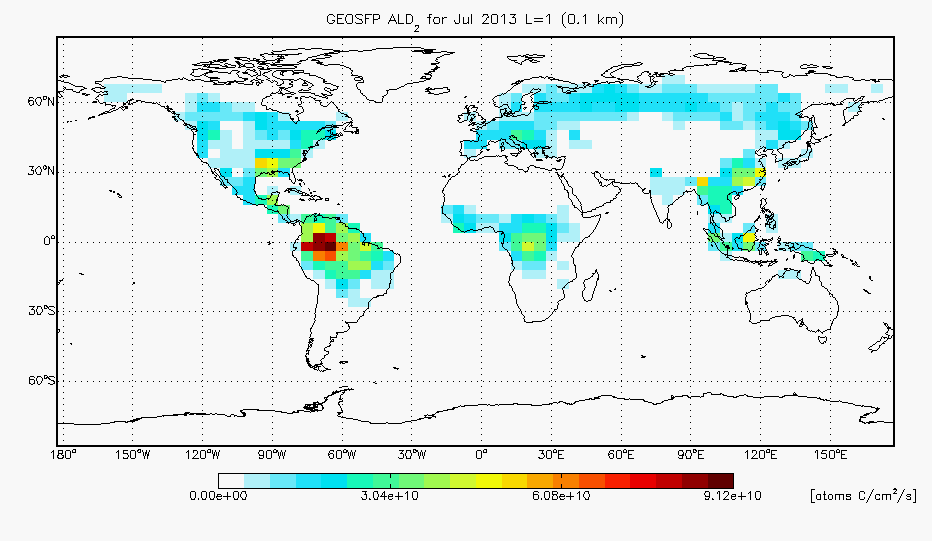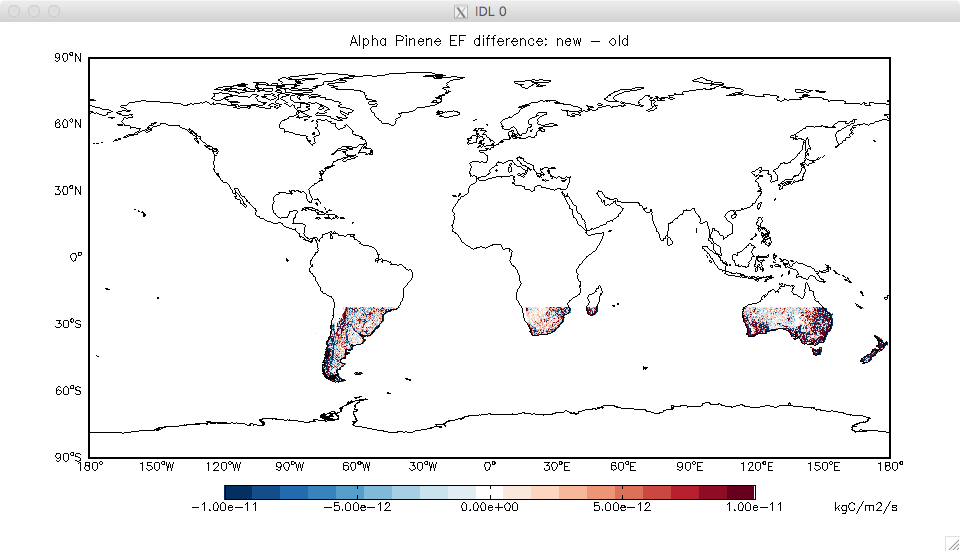MEGAN v2.1 plus Guenther 2012 biogenic emissions
On this page we describe the MEGAN v2.1 plus Guenther et al 2012 biogenic emissions, which are used in GEOS-Chem v10-01 and newer versions. The MEGAN emissions are fed into GEOS-Chem via the HEMCO emissions component.
Overview
Description
Dylan Millet wrote:
GEOS-Chem emission routines for biogenic VOCs have been updated to MEGAN2.1 as described in Guenther et al., Geosci. Model Dev., 5, 1471–1492, 2012. (Article) The net result is a 11-12% decrease in the global flux for isoprene, and a 30% increase in the global flux for total monoterpenes. Biogenic alkene emissions are now computed using MEGAN instead of by scaling to isoprene, as was done previously. Biogenic emissions of acetaldehyde are now included. Annual emission totals at 2x2.5 resolution for the different compounds are within ~20% of the values in Table 6 of Guenther et al., within the expected uncertainty associated with differing meteorology, years, etc. Note that global emissions can also change by 10% or more when running at 2x2.5 versus 4x5 degree horizontal resolution (for both the updated and the standard emission routines).
One of the ‘under-the-hood’ changes is that there is now a single driver routine for calculating MEGAN emissions across all compounds (GET_MEGAN_EMISSIONS). Previously we had separate driver routines for each individual compound. GET_MEGAN_EMISSIONS is passed the compound name, looks up or computes the appropriate parameters, and returns the corresponding emissions. This should hopefully make it much easier to add new compounds in the future, since one just has to add the appropriate parameter values for that compound. There are parameters included for a number of compounds not presently in the standard chemistry scheme - for use in specialized simulations and/or future inclusion in standard fullchem. Another under-the-hood change is that the PCEEA/PECCA flag is no longer needed since we use this scheme exclusively now.
The new MEGAN implementation computes emissions for certain compounds based on pre-defined emission factor maps provided with the MEGAN source code. For other compounds emissions are computed in GEOS-Chem based on CLM4 plant functional type distributions combined with PFT-specific emission factors. This PFT approach can be used for all MEGAN compounds if desired (by adding in the corresponding emission factors for each PFT), which may be useful for applications using different vegetation maps or dynamically shifting vegetation.
The updated emissions lead to lower CO concentrations in the Northern Hemisphere during summer. A GEOS-Chem v9-01-03 4x5 run for 2006 gave CO mixing ratios averaged for P>800 hPa) that were lower by a few ppb over much of the Northern Hemisphere during ummer months. Maximum decreases of about 10ppb occur over certain source regions. Ox changes are small (< 2ppb for P > 800hPa) using the standard v9-1-3 (non-Caltech) chemistry scheme.
Please contact Dylan Millet with any further questions about these emissions.
--Bob Y. 16:05, 25 February 2015 (EST)
Documentation
- Comparison between previous and updated BVOC emissions for standard tracers (nested NA, year-2011):
- Updated emissions for all BVOCs, including non-standard tracers:
- Monthly CO comparison for previous and updated MEGAN implementation (year-2006; 4x5 resolution):
--Dbm 14:18, 22 January 2013 (EST)
Data files
In GEOS-Chem v10-01 and newer versions, the MEGAN v2.1 plus Guenther (2012) biogenic emissions are read with the HEMCO emissions component. We have created new MEGAN data files (in COARDS-compliant netCDF format) for use with HEMCO. These new data files are contained in the HEMCO data directory tree. For detailed instructions on how to download these data files to your disk server, please see our Downloading the HEMCO data directories wiki post.
--Bob Y. 13:19, 3 March 2015 (EST)
Discussion following 1-month benchmark v10-01h
This emission scheme was validated in GEOS-Chem v10-01h. The following discussion ensued.
Dylan Millet wrote:
- A few comments and questions below.
- 1. Acetone
- Based on the benchmarking I did earlier biogenic acetone emissions should increase 6-7% globally & annually with the MEGAN update. But the emission ratio plot for ACET in the new benchmark shows a >2x increase everywhere. On the emission summary page, the "biogenic and natural' acetone sources look to have increased from 1.6 to 5.2. But if we look on the same page at the "acetone sources" the two simulations are very similar and the sum is consistent with a ~7% increase. In other words the large discrepancy in the emission ratio plot and in the "biogenic and natural sources" table for acetone just looks to be a correction to the way the diagnostics are being done. Is that right? Consistent with that, the concentration ratios are not very different.
- 2. Isoprene
- I'd expect about a 10-12% isoprene decrease globally & annually for isoprene emissions. The new benchmark has a ~30% decrease. I'm not sure why that would be. It could just be the difference between a 1-month run and a full year, or interannual variability, I suppose, though the discrepancy seems large for that. Does the 10-01f benchmark we're comparing to use the (old) standard canopy treatment, or does it use the PCEEA parameterization? That was an option before, but we got rid of it with the MEGAN update (which only uses PCEEA). If we're switching canopy schemes that might explain the difference.
- 3. For propene I expect about a 50% increase globally. The change we see in the benchmark is larger (67%) but not dramatically.
- 4. Since we now have biogenic emissions of ALD2 we should add the appropriate biogenic benchmark diagnostics.
Melissa Sulprizio wrote:
- 1. Acetone
- That is correct. Prior to this version, there was a bug in diag3.F in the conversion to atomsC/cm2/s that affected the biogenic acetone diagnostic (ND46). The error appears to have come in with the implementation of HEMCO. We corrected the unit conversion in this version and the biogenic acetone emissions are now more consistent with pre-HEMCO values.
- 2. Isoprene
- The PECCA/PCEEA model was turned off in the old benchmarks, so that may explain the difference. From the HEMCO.log file for the previous benchmark (v10-01f_UCX), we have:
Use MEGAN biogenic emissions (extension module)
- Use PECCA model: F
- Use the following species:
Isoprene = ISOP 1
Acetone = ACET 26
C3 Alkenes = PRPE 23
Ethene = C2H4 -1
--> Isoprene scale factor is 1.00000000000000
- MEGAN monoterpene option enabled:
CO = CO 31
OC aorosol = OCPI 16
Monoterp. = MONX -1
- 3. Propene
- Could it be that the difference in meteorology fields is causing this difference? It looks like your benchmarks used GEOS-5 met fields for 2006. In v10-01h, we are using GEOS-FP met fields for July 2013.
- 4. Diagnostics
- I have added ALD2 to the benchmark plotting routines. We were unable to make difference plots for this version since v10-01f_UCX didn’t include biogenic emissions of ALD2 so I have that update commented out for now, but we will include differences of ALD2 biogenic emissions in future benchmarks. For your reference, I have included a map of the ALD2 biogenic emissions from v10-01h below:
Dylan Millet wrote:
- Ok, that all seems reasonable. The only question left in my mind is the 30% isoprene decrease compared to 10% that I saw earlier. I've started a run testing the impact of switching canopy schemes to see if that accounts for it.
- Based on my original implementation of the MEGAN update, changing the MEGAN algorithms and EFs gives a 10-11% reduction in global emissions. Changing the canopy scheme gives another 7-8% decrease. So the total expected decrease (18%) is still less than we see with the new benchmark (30%), but close enough that it could be due to 1 month versus 1 year, different met fields, interannual variability, etc. I vote for moving ahead and having a look at the 1-y benchmark.
--Melissa Sulprizio 13:12, 27 March 2015 (EDT)
Discussion of LAI Data Sources
Barron Henderson wrote:
- LAI products from MODIS come from many sources, some of which are more recent than the ones in GEOS-Chem at this time. I explored both the MODIS product using very basic processing and the product described by Yuan et al. 2011. I propose updating LAI to the product described by Yuan et al. 2011. This product is available from 2000 through 2015 and was previously applied with MEGAN by Sindelarova et al. (2014). I performed tests with GEOS-Chem v9-02 and saw generally consistent results.
- I processed LAI for 2008-2010 and simulated isoprene emissions for 2010 using both the product already in GEOS-Chem and the Yuan et al. (2011) product. LAI varies both intra and inter-annually. GEOS-Chem currently applies year-specific LAI for 2005-2009. Beyond 2009, GEOS-Chem currently uses LAI from 2008. Before 2005, GEOS-Chem currently uses LAI from 2005. By comparing LAI from 2008, we can understand the difference between LAI products. Looking at isoprene emissions from 2010 estimates the difference due to LAI product and the effect of interannual variability.
- The differences between products (the product we currently use, basic processing of MODIS, and Yuan) is larger than the differences between years. The Yuan product having been used in Sindelarova (2014) with Guenther as a co-author and explicit discussion of better gap filling leads me to select the Yuan product.
- Using the Yuan product reduces isoprene emissions by 4-7% per month (see File:README LAI BNU.txt). In specific locations, the differences can be quite high. These may be a combination of edge effects where spatial processing was different, gap filling, and a difference in the LAI maximum. Sindelarova et al (2014) applied the Yuan dataset with a 7 m2/m2 maximum, which was not applied in my tests and may account for some large differences. The largest differences occur in areas with the lowest emissions.
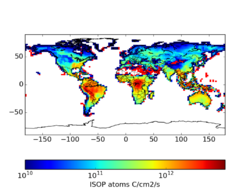
|
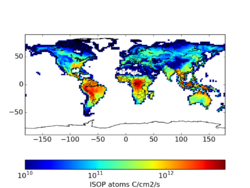
|
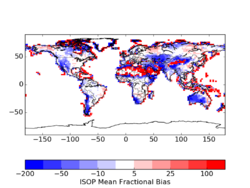
|
| Standard | From Yuan | 2*(Yuan - STD)/(Yuan+STD) |
- For 2010, there is not a huge difference that motivates a high priority implementation. However, upon further reflection, this update seems easy and practical. It also has the added benefit of providing a consistent product for a 15-year period.
- Yuan, H., Dai, Y., Xiao, Z., Ji, D., Shangguan, W., 2011. Reprocessing the MODIS Leaf Area Index Products for Land Surface and Climate Modelling. Remote Sensing of Environment, 115(5), 1171-1187. doi:10.1016/j.rse.2011.01.001,
- Sindelarova, K., Granier, C., Bouarar, I., Guenther, A., Tilmes, S., Stavrakou, T., Müller, J.-F., Kuhn, U., Stefani, P., and Knorr, W.: Global data set of biogenic VOC emissions calculated by the MEGAN model over the last 30 years, Atmos. Chem. Phys., 14, 9317-9341, doi:10.5194/acp-14-9317-2014, 2014.
--barronh 11:30, 4 Nov 2016 (EDT) edited drastically at 2:08pm.
Jenny Fisher followed up on 5/31/2018:
- I have downloaded and processed the Yuan BNU MODIS LAI product for 2005-2016.
- There are a couple of caveats:
- The MODIS LAI files seem to be some of the only lingering files left that are NOT read by HEMCO. This means that there is a bunch of hardcoding associated with reading the files. And a few issues associated with that:
- Although the files are provided at very high resolution (and I could have regridded to match GEOS-Chem resolution, or something else that would be useful in future), I had to maintain these at generic 0.25°x0.25° to match what was already done in modis_lai_mod.F
- The new files operate on a different time basis (weekly vs. monthly) so there were a number of hardcoded changes required to facilitate weekly reading.
- I haven’t benchmarked the impact of the changes. Barron did this when he prepared some of the files (that’s what is on the wiki page you linked to), but I prepared my versions separately (and slightly differently, i.e. including a maximum LAI value) so the comparison would look different.
- For #1 – I think the issues would be solved if GCST could translate the existing MODIS LAI reading code into HEMCO (as HEMCO could handle the different resolutions and time periods). Is that a possibility?
- For #2 – unfortunately I don’t have the resources to do any extra runs at the moment, so I can’t test the global impacts. But assuming this update is not coupled with other isoprene emission updates, the normal GCST benchmarking procedure would show us how much impact it had.
Lizzie Lundgren wrote:
- I believe the hard-coded regridding of MODIS LAI from fine to coarse resolution within GEOS-Chem Classic is due to the dependence on the Olson land map for regridding. I don’t think HEMCO currently has the capacity to do this, but Christoph please correct me if I am wrong. We actually bypass the hard-coded regridding entirely in GCHP and use MAPL ExtData instead. However, this required GMAO to implement a fractional regridding algorithm within ExtData which GMAO graciously did for us. I wonder if we could do something similar in HEMCO?
Christoph Keller wrote:
- What I did in GEOS-5 (prior to the ExtData update) was to create a separate mask for every Olson land type, which can then be regridded using the regular regridding routines. This could be a workaround for GC classic.
--Lizzie Lundgren (talk) 13:47, 1 June 2018 (UTC)
Global 0.25x0.25 MEGAN input and MODIS LAI
This update was included in v11-02f (approved 17 May 2018).
Jenny Fisher wrote:
- The summary version of the issue is:
- Several years back, Mike got a version of the raw MODIS LAI files from BU on a 0.25°x0.25° grid. These had some sort of projection error that led to the weird behaviour I saw over Australia (offsetting along the southern coasts of Australia, w/ some SW ocean grid boxes having LAI > 0 and some SE land boxes having LAI = 0).
- Mike processed those files to a 0.5°x0.5° version for input to GEOS-Chem. This was NOT just regridding the original files, but also making some adjustments following Muller et al. 2008*.
- These were the files in the archive for some unknown period of time.
- Eventually (for HEMCO? Or 0.25x0.3125? or both?) someone must have regridded these 0.5°x0.5° files back to 0.25°x0.25°.
- In the meantime, Eloise received an updated version of the raw MODIS LAI files from BU on a 0.25°x0.25° grid. These did not have the projection error.
- AFAIK, Eloise has not applied the same type of processing Mike did – so what I have now are just the raw data converted to HEMCO format.
- After all of this, my recommendation for moving forward is that we replace the existing files currently used in GEOS-Chem with the versions from Eloise (I now have scripts to prepare these for HEMCO).
Dylan Millet response:
- Using the raw, unscaled LAI files sounds like the way to go for the purposes of other modules. The scaling to the fraction of vegetated area will need to take place inside the megan module. As I recall, since the EFs are already scaled to their fractional coverage, we need to apply scaled LAI (i.e. the LAI for the vegetated area) otherwise we will be underestimating the flux ... in effect double-counting the effect of fractional vegetation coverage.
- I think it would be better to have a single change where both the LAI files and the scaling are taken care of, and also that we should do a quick assessment of how the isoprene flux changes from the prior version, before sending in as a patch for the mainline code.
- The LAI scaling is a simple matter, it just means dividing the LAI by the fraction of the grid square that is covered by vegetation before computing GAMMA_LAI. In other words, MISOLAI needs to be divided by the sum of ARRAY_16(:,:,2:16) prior to GET_GAMMA_LAI in the current version of the code. I guess with a trap to avoid dividing by zero. (Mike, can you confirm that's what happened with the LAI data you produced?) I can certainly work with Christoph to implement (when I get a moment!) but the only thing that requires any thought at all is just the passing of that PFT data into get_megan_emissions as right now it is dealt with in calc_aef.
Christoph Keller response:
- If it's just a matter of normalizing MISOLAI by the PFTs (ARRAY_16) within GET_MEGAN_EMISSIONS then this is a quick fix that I'm happy to provide.
- My only concern would be that the new code should only be used with the updated files. It would be good to make the code stop if the MEGAN module and input files are inconsistent to avoid users mixing up wild combinations of code and data!
Christoph Keller follow-up:
- Attached is a git patch that normalizes MEGAN LAI by PFT. Do you want to do some internal validation / sensitivity analysis before sending it off to the GCST?
- The patch is based of GEOS-Chem v11-01. You should be able to apply it using
git apply Normalize-MEGAN-LAI.patch
- Two comments:
- I did not change the hard-coded path of the LAI files in modis_lai_mod.F90 because it would break my code (I had to set it to a local directory when testing the code).
- I added an optional HEMCO setting to control MEGAN LAI normalization (in HEMCO_Config.rc)
108 MEGAN : on ISOP/ACET/PRPE/C2H4/ALD2
--> Isoprene scaling : 1.0
--> CO2 inhibition : true
--> CO2 conc (ppmv) : 390.0
--> Normalize LAI : false
- You don't have to specify the Normalize LAI setting, it is set to 'true' by default. But this gives you the option to (a) use this version of HEMCO with the old LAI files and (b) test the impact of normalizing the LAI values vs. using the new LAI files without normalization.
--Melissa Sulprizio (talk) 15:32, 20 July 2017 (UTC)
CO2 direct effect on isoprene emissions
This update was validated with 1-month benchmark simulation v11-01d and 1-year benchmark simulation v11-01d-Run1. This version was approved on 12 Dec 2015.
Amos Tai developed code updates to include CO2 inhibition of isoprene emissions in MEGAN.
The reference for this work is:
- Tai, A.P.K., L.J. Mickley, C.L. Heald, S. Wu, Effect of CO2 inhibition on biogenic isoprene emission: Implications for air quality under 2000-to-2050 changes in climate, vegetation, and land use, Geophys. Res. Let., 40, 3479-3483, 2013. [pdf]
--Melissa Sulprizio 15:45, 23 January 2014 (EST)
References
- Barkley, M., Description of MEGAN biogenic VOC emissions in GEOS-Chem, 2010. PDF
- Buermann, W., Wang, Y.J., Dong, J.R., Zhou, L.M., Zeng, X.B., Dickinson, R.E., Potter, C.S., and Myneni, R.B.: Analysis of a multiyear global vegetation leaf area index data set, J. Geophys. Res., 107, 4646, doi:10.1029/2001JD000975, 2002.
- Guenther, A., Baugh, B., Brasseur, G., Greenberg, J., Harley, P., Klinger, L., Serca, D., and Vierling, L.: Isoprene emission estimates and uncertainties for the Central African EXPRESSO study domain, J. Geophys. Res., 104, 30625-30639, 1999.
- Guenther, A., Karl, T., Harley, P., Wiedinmyer, C., Palmer, P.I., and Geron, C.: Estimates of global terrestrial isoprene emissions using MEGAN (Model of Emissions of Gases and Aerosols from Nature), Atmos. Chem. Phys., 6, 3181-3210, 2006.
- Guenther, A., and C. Wiedinmyer, User's guide to the Model of Emissions of Gases and Aerosols from Nature (MEGAN), Version 2.01, 2007.
- Guenther, A. B., Jiang, X., Heald, C. L., Sakulyanontvittaya, T., Duhl, T., Emmons, L. K., and Wang, X.: The Model of Emissions of Gases and Aerosols from Nature version 2.1 (MEGAN2.1): an extended and updated framework for modeling biogenic emissions, Geosci. Model Dev., 5, 1471-1492, doi:10.5194/gmd-5-1471-2012, 2012. Article
- Millet, D.B., Jacob, D.J., Boersma, K.F., Fu, T.M., Kurosu, T.P., Chance, K., Heald, C.L., and Guenther, A.: Spatial distribution of isoprene emissions from North America derived from formaldehyde column measurements by the OMI satellite sensor, J. Geophys. Res., 113, D02307, doi:10.1029/2007JD008950, 2008. PDF
- Mueller, J.-F., et al. Global isoprene emissions estimated using MEGAN, ECMWF analyses and a detailed canopy environment model, Atmos. Chem. Phys., 8, 1329-1341, 2008.
- Myneni, R. B., et al., Large seasonal swings in leaf area of Amazon rainforests, Proceedings of the National Academy of Sciences, 104(12), 4820{4823, doi:10.1073/pnas.0611338104, 2007.
- Palmer, P.I., Abbot, D.S., Fu, T.M., Jacob, D.J., Chance, K., Kurosu, T.P., Guenther, A., Wiedinmyer, C., Stanton, J.C., Pilling, M.J., Pressley, S.N., Lamb, B., and Sumner, A.L.: Quantifying the seasonal and interannual variability of North American isoprene emissions using satellite observations of the formaldehyde column, J. Geophys. Res., 111, D12315, doi:10.1029/2005JD006689, 2006. PDF
- Sakulyanontvittaya, T., T. Duhl, C. Wiedinmyer, D. Helmig, S. Matsunaga, M. Potosnak, J. Milford, and A. Guenther, Monoterpene and Sesquiterpene Emission Estimates for the United States, Environ. Sci. Technol., 42(5), 1623{1629, doi:10.1021/es702274e, 2008.
- Tai, A.P.K., L.J. Mickley, C.L. Heald, S. Wu, Effect of CO2 inhibition on biogenic isoprene emission: Implications for air quality under 2000-to-2050 changes in climate, vegetation, and land use, Geophys. Res. Let., 40, 3479-3483, 2013. [pdf]
--Bob Y. 15:49, 25 February 2015 (EST)
Previous issues that are now resolved
Grid offset bug fix in high-resolution MEGAN files at southern mid-latitudes
This fix will be implemented during the v11-02 provisional release period
Jenny Fisher wrote:
- I’ve discovered a bug in some of the high-resolution files used for MEGAN (previously provided in the MEGAN/v2017-07/). For one species (alpha pinene) there was a strange offset of the grid that affected the southern mid-latitudes. With Dylan’s help, we traced this to the original very high resolution MEGAN input files provided by Alex Guenther’s group. These were updated in Nov 2016, removing the offset.
- I’ve recreated the HEMCO-ready version of these files, and they are available for download. This is definitely a bug fix, so should get implemented during the v11-02 provisional release period (really just a file update so it’s easy). Note that the update will ONLY affect anyone looking at monoterpenes (specifically MTPA) in the southern mid-latitudes – see attached difference plot.
The new files are stored in ExtData/HEMCO/MEGAN/v2018-05/ with an accompanying README.
--Lizzie Lundgren (talk) 14:55, 31 May 2018 (UTC)
Bug fix for monoterpenes in ND46 diagnostic
This fix was validated with the 1-month benchmark simulation v11-01c and approved on 14 Sept 2015.
Jared Brewer wrote:
- I'm now working with the public release of GEOS-Chem v10-01, and I'm reaching out to you regarding a possible bug that I've identified in the monoterpene outputs in the BIOGSRCE diagnostic in diag3.F - specifically the FACTOR code in line 4028. At this line, the program claims it is converting from KgC/m2/s to AtomsC/cm2/s, but includes the factor of 10 for conversion from Kg monoterpene to atoms C (IE, 10 carbons/monoterpene). This bug would appear to be common in all the different monoterpene emissions as well (A-Pinene, Ocimene, etc.).
To resolve this issue, we have removed the number of carbons per molecume (10 for monoterpenes, 15 for sesquiterpenes, etc.( from the conversion factors in diag3.F.
--Melissa Sulprizio (talk) 18:36, 9 September 2015 (UTC)
Minor bug fix in MEGAN_Mono extension
This update was added as a last-minute fix to GEOS-Chem v10-01. It was included in the GEOS-Chem v10-01 public release (17 Jun 2015).
Christoph Keller wrote:
- I came across a small bug in MEGAN: I tried to run the "standard" MEGAN only, i.e. without the monoterpenes, but this would give me zeros for all emissions except isoprene because the CLM4 arrays were only being read if MEGAN extension 109 (MEGAN_mono) was enabled. So in the configuration file, we need to link the CLM4 arrays to extension 108, not 109:
108 CLM4_PFT_BARE $ROOT/MEGAN/v2015-02/CLM4_PFT.geos.1x1.nc PFT_BARE 2000/1/1/0 C xy 1 * - 1 1
- etc. Furthermore, I made two small updates in HEMCO/Extensions/hcox_megan_mod.F for better error trapping and to avoid out-of-bounds errors:
- 1. In the run driver (HCOX_Megan_Run), evaluate the error return code of CALC_AEF and CALC_NORM_FAC:
IF ( FIRST ) THEN
! Generate annual emission factors for MEGAN inventory
CALL CALC_AEF( am_I_Root, HcoState, ExtState, RC )
IF ( RC /= HCO_SUCCESS ) RETURN
! Calculate normalization factor (dbm, 11/2012)
CALL CALC_NORM_FAC( am_I_Root, RC )
IF ( RC /= HCO_SUCCESS ) RETURN
ENDIF
- 2. In routine CALC_AEF, check if arrays are really used:
! Convert AEF arrays to [kgC/m2/s]
! Multiply arrays by FACTOR and ratio [g C/g compound]
! NOTE: AEFs for ISOP, MBOX, BPIN, CARE, LIMO, OCIM, SABI
! are read from file in [kgC/m2/s], so no need to convert here
IF ( ExtNrMono > 0 ) THEN
AEF_APIN(I,J) = AEF_APIN(I,J)
& * FACTOR * 120.0_hp / 136.234_hp
AEF_MYRC(I,J) = AEF_MYRC(I,J)
& * FACTOR * 120.0_hp / 136.234_hp
AEF_OMON(I,J) = AEF_OMON(I,J)
& * FACTOR * 120.0_hp / 136.234_hp
ENDIF
- Note that these fixes do not affect the benchmarks since the benchmarks run with MEGAN_Mono turned on.
--Bob Y. 16:54, 28 April 2015 (EDT)
Restore missing BIOGENIC_CO diagnostics
This update was added as a last-minute fix to GEOS-Chem v10-01. It was included in the GEOS-Chem v10-01 public release (17 Jun 2015).
Dylan Millet wrote:
CO SOURCES
Tracer v10-01e-geosfp-Run1 v10-01h-geosfp-Run0 v10-01i-geosfp-Run0
============================================================================
COan+bf 527.122265 598.575584 608.052597 Tg
CObb 283.579062 296.993630 293.039311 Tg
COmono 34.826250 41.440323 0.000000 Tg
- Why did the CO source from terpenes change [in GEOS-Chem v10-01]? It looks like it went to zero? Is that just a change in the diagnostic?
Bob Yantosca replied:
- The zero CO from monoterpenes is a diagnostic issue. I looked through the logs from a recent simulation and I saw:
HEMCO WARNING: Diagnostics counter is zero - return empty array: BIOGENIC_CO --> LOCATION: DiagnCont_PrepareOutput (hco_diagn_mod.F90)
- Melissa and I just traced this to an omission in the HEMCO MEGAN extension (module HEMCO/Extensions/hcox_megan_mod.F). HEMCO was computing the CO emissions from monoterpenes properly. But these emissions were not being added to the proper diagnostic container (called BIOGENIC_CO) in HEMCO’s data structure. Therefore, when we went to print out these emissions, they showed up as all zeroes.
- It appears that the subroutine call to add the CO emissions from monoterpenes to the diagnostics had been somehow removed from the GEOS-Chem v10-01i code. We think that this may have been “clobbered” by a recent Git merge. In any case, adding the lines in GREEN correct this issue:
! ----------------------------------------------------------------
! CO
IF ( ( ExtNrMono > 0 ) .AND. ( IDTCO > 0 ) ) THEN
! Add flux to emission array
CALL HCO_EmisAdd( am_I_Root, HcoState, FLUXCO, IDTCO,
& RC, ExtNr=ExtNr )
IF ( RC /= HCO_SUCCESS ) THEN
CALL HCO_ERROR( 'HCO_EmisAdd error: FLUXCO', RC )
RETURN
ENDIF
! Also archive the BIOGENIC_CO diagnostic (bmy, 4/29/15)
Arr2D => FLUXCO
DiagnName = 'BIOGENIC_CO'
CALL Diagn_Update( am_I_Root, ExtNr=ExtNrMono,
& cName=TRIM(DiagnName), Array2D=Arr2D, RC=RC)
IF ( RC /= HCO_SUCCESS ) RETURN
Arr2D => NULL()
ENDIF
- With the fix installed, HEMCO now successfully adds the CO emitted from monoterpenes to the BIOGENIC_CO diagnostic instead of printing out all zeroes.
--Bob Y. 12:01, 29 April 2015 (EDT)
